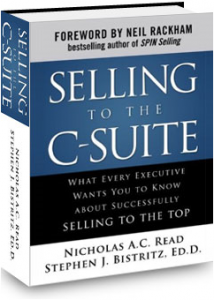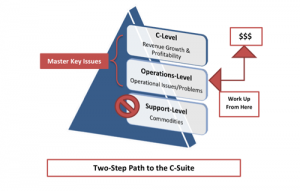Will C-level Executives Meet With Sales People?
 Will C-level executives meet with sales people? The answer is yes, but it takes 240 pages to explain why that is the case and what a sales person can use this insight for. That’s 240 pages of high value.
Will C-level executives meet with sales people? The answer is yes, but it takes 240 pages to explain why that is the case and what a sales person can use this insight for. That’s 240 pages of high value.
“Why should a sales person want to meet with C-level executives?”
“What do the C-level executives expect from such meetings?”
“What must the sales person do to get the first meeting and then a second meeting to continue and expand the relationship?”
These question and many more are answered in the book “Selling to the C-Suite” by Nicholas A.C. Read and Stephen J. Bistritz.
If you sell big ticket items that may have a strategic impact on your customers’ business, then your ability to get access to C-level executives can make a huge difference. The book is an excellent manual for making this happen, but I need to warn you. It is not a walk in the park and it may take a major investment in time and effort to bring you to where you can communicate effectively with C-level executives.
What doesn’t kill you makes you stronger
In my second year in sales (1982) I was working on a €20M deal with a potential new customer. Back then I was selling mainframe computers and bespoke software development for Control Data Corporation. We were very well positioned for this deal and I felt we had a strong value proposition. The customer was very responsive and the CIO was busy building up the case to promote our proposal. From an internal source I learned that the committee reviewing the proposals didn’t agree on the choice of vendor, but that there was a majority in favour of the Control Data proposal.
 Then suddenly everything went quiet and I couldn’t reach anyone. Two weeks later I read in the newspaper that the CIO had been fired, the committee dismissed and an external consultant was called in to help the board of directors work out an IT strategy for the company. Two weeks later the company announced that they had decided to go with IBM. €20M flew out of my pockets (where they had never been) and into the pockets of IBM.
Then suddenly everything went quiet and I couldn’t reach anyone. Two weeks later I read in the newspaper that the CIO had been fired, the committee dismissed and an external consultant was called in to help the board of directors work out an IT strategy for the company. Two weeks later the company announced that they had decided to go with IBM. €20M flew out of my pockets (where they had never been) and into the pockets of IBM.
I called a meeting with all the people involved to make sure we at least learned something from this case. The situation was that we may have had a technically better solution that the CIO preferred, but IBM was the global market leader in this business segment, which the board of directors found more important. IBM also had considerably more muscle than we had and they had a formidable ability of selling at all levels in an organization.
I learned that entering at the time where a company calls for proposals is way too late. Without established relationships all doors are closed when a company enters the vendor selection process. In reality we never stood a chance of winning this customer against IBM, because we started way too late and showed no interest before they called us (and all the other mainframe providers).
The business side of information technology
The first years of my career as a sales representative were difficult because I struggled with understanding computer operations and software development. After losing the big deal to IBM it dawned on me that I didn’t have to understand IT operations and software development in their technical details. I could leave the technical issues to our professional tech-support people and then I could focus on the business side of the customer’s investment. That became my trademark and suddenly I preferred talking to the C-level executives because I was more interested in the WHY than in the HOW and the WHAT. The HOW and WHAT were also important, but we had plenty of technical expertise that we could deploy to ensure that the solutions we proposed could be implemented and would be delivering the value we had promised/agreed to.
The three levels of responsibility
 Selling to the C-Suite introduces “The three levels of responsibility” that we find in any organisation.
Selling to the C-Suite introduces “The three levels of responsibility” that we find in any organisation.
At the operational level we are concerned about daily operational issues. We have a job to do and any investment is assessed based on how it will affect us. Will it make me redundant? Will it change my job? Can I learn the new way of doing things? Will it make my life more difficult or more pleasant?
At the middle management level we are concerned with the organisational impact and implications. The manager responsible for executing the investment (and selecting the vendor) and delivering on the business case is carefully weeding out risk elements and making contingency plans for the most obvious pitfalls. The purchase department will put pressure on the vendor to squeeze the price while improving other terms and conditions.
The C-level is considering if this really is a better investment than the other alternatives we have, if making this investment is just a trivial operational activity or if we can make it serve some of our strategic objectives. We are looking for new ways to improve our overall market position, supporting growth and delivering shareholder value.
Mastering the C-level language and broadcasting on the C-band
The book explains how getting access to the C-level can make an enormous difference, and it clearly spells out when and how we can get there. It uses several chapters explaining what kind of language we need to speak if we want value from the meeting and not risk being banned and damaging our personal reputation and that of our company.
 Selling to the C-level is not only something the individual sales person decides for herself. She needs the support from the company’s marketing resources creating content that can reach executives as they do early research on answers to their strategic questions. They need the support of sales development spotting companies and executives very early BEFORE they start communicating with vendors, because then it is too late and the C-level executives are out of the loop.
Selling to the C-level is not only something the individual sales person decides for herself. She needs the support from the company’s marketing resources creating content that can reach executives as they do early research on answers to their strategic questions. They need the support of sales development spotting companies and executives very early BEFORE they start communicating with vendors, because then it is too late and the C-level executives are out of the loop.
Selling to the C-Suite was published in 2009, but it hasn’t lost any relevance and actuality in the 7 years that have passed.







